MAFI1A-8: Management Accounting & GTZ Group Efficiency Analysis
VerifiedAdded on 2023/04/19
|11
|2107
|185
Homework Assignment
AI Summary
This assignment delves into various aspects of management accounting, focusing on enhancing business efficiency and performance within the context of the GTZ Group. It covers topics such as incremental revenue analysis for decision-making, motivational factors for employees, promotional pricing techniques, and pricing strategies like price skimming. The assignment includes a detailed calculation of profit-maximizing selling prices and a discussion on the importance of reconsidering pricing policies in response to market competition. Furthermore, it examines product lifecycle stages and their impact on pricing and cost management. The assignment also provides a comparative analysis of traditional costing systems versus activity-based costing (ABC) and their effects on product unit costs, along with a discussion on the rationale behind the differences observed. This comprehensive analysis is designed to provide practical insights into improving business operations through effective management accounting practices. Desklib offers a range of similar resources for students seeking further assistance.

Management accounting
Paraphrase This Document
Need a fresh take? Get an instant paraphrase of this document with our AI Paraphraser
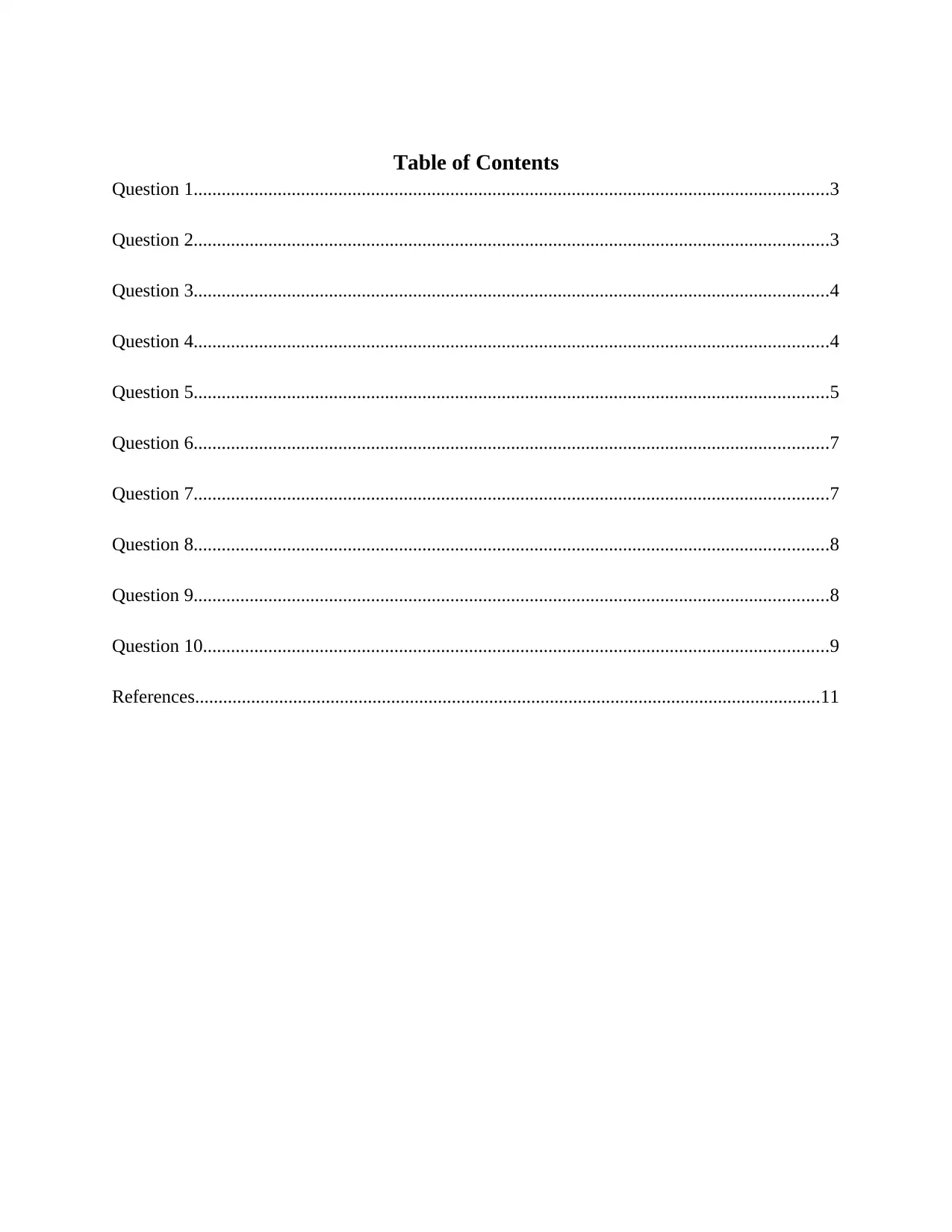
Table of Contents
Question 1........................................................................................................................................3
Question 2........................................................................................................................................3
Question 3........................................................................................................................................4
Question 4........................................................................................................................................4
Question 5........................................................................................................................................5
Question 6........................................................................................................................................7
Question 7........................................................................................................................................7
Question 8........................................................................................................................................8
Question 9........................................................................................................................................8
Question 10......................................................................................................................................9
References......................................................................................................................................11
Question 1........................................................................................................................................3
Question 2........................................................................................................................................3
Question 3........................................................................................................................................4
Question 4........................................................................................................................................4
Question 5........................................................................................................................................5
Question 6........................................................................................................................................7
Question 7........................................................................................................................................7
Question 8........................................................................................................................................8
Question 9........................................................................................................................................8
Question 10......................................................................................................................................9
References......................................................................................................................................11

QUESTION 1
For the C & T, Opening the store on Sunday is justifiable only if, incremental revenue exceeds
from the incremental cost of the product. The statement related to the computation of
incremental revenue or cost is given below –
Table 1: Statement Showing Whether Stores Should be opened on Sunday or not
Particulars Amount
Incremental Revenue 9000000
Gross Profit 4050000
Wages to Sales Assistants on Sundays 270000
Commission to Manager 180000
Lighting Cost 120000
Heating Cost 262500
Incremental Revenue 3217500
On the basis of the above calculations, it has been seen that by opening the store on Sunday, C &
T can earn 3217500; therefore it is justifiable to open the store on Sunday.
QUESTION 2
Factors of Motivation
In the given study, it is stated that, if the manager is worked on Sunday then he is allowed to take
the equivalent time off during the week and also a bonus is granted of 2% on the extra sales
generated on the Sunday project. There are some internal and external elements that encourage
desire and energy in people to regularly interest and committed for a job or role (Wang et al.
For the C & T, Opening the store on Sunday is justifiable only if, incremental revenue exceeds
from the incremental cost of the product. The statement related to the computation of
incremental revenue or cost is given below –
Table 1: Statement Showing Whether Stores Should be opened on Sunday or not
Particulars Amount
Incremental Revenue 9000000
Gross Profit 4050000
Wages to Sales Assistants on Sundays 270000
Commission to Manager 180000
Lighting Cost 120000
Heating Cost 262500
Incremental Revenue 3217500
On the basis of the above calculations, it has been seen that by opening the store on Sunday, C &
T can earn 3217500; therefore it is justifiable to open the store on Sunday.
QUESTION 2
Factors of Motivation
In the given study, it is stated that, if the manager is worked on Sunday then he is allowed to take
the equivalent time off during the week and also a bonus is granted of 2% on the extra sales
generated on the Sunday project. There are some internal and external elements that encourage
desire and energy in people to regularly interest and committed for a job or role (Wang et al.
⊘ This is a preview!⊘
Do you want full access?
Subscribe today to unlock all pages.

Trusted by 1+ million students worldwide
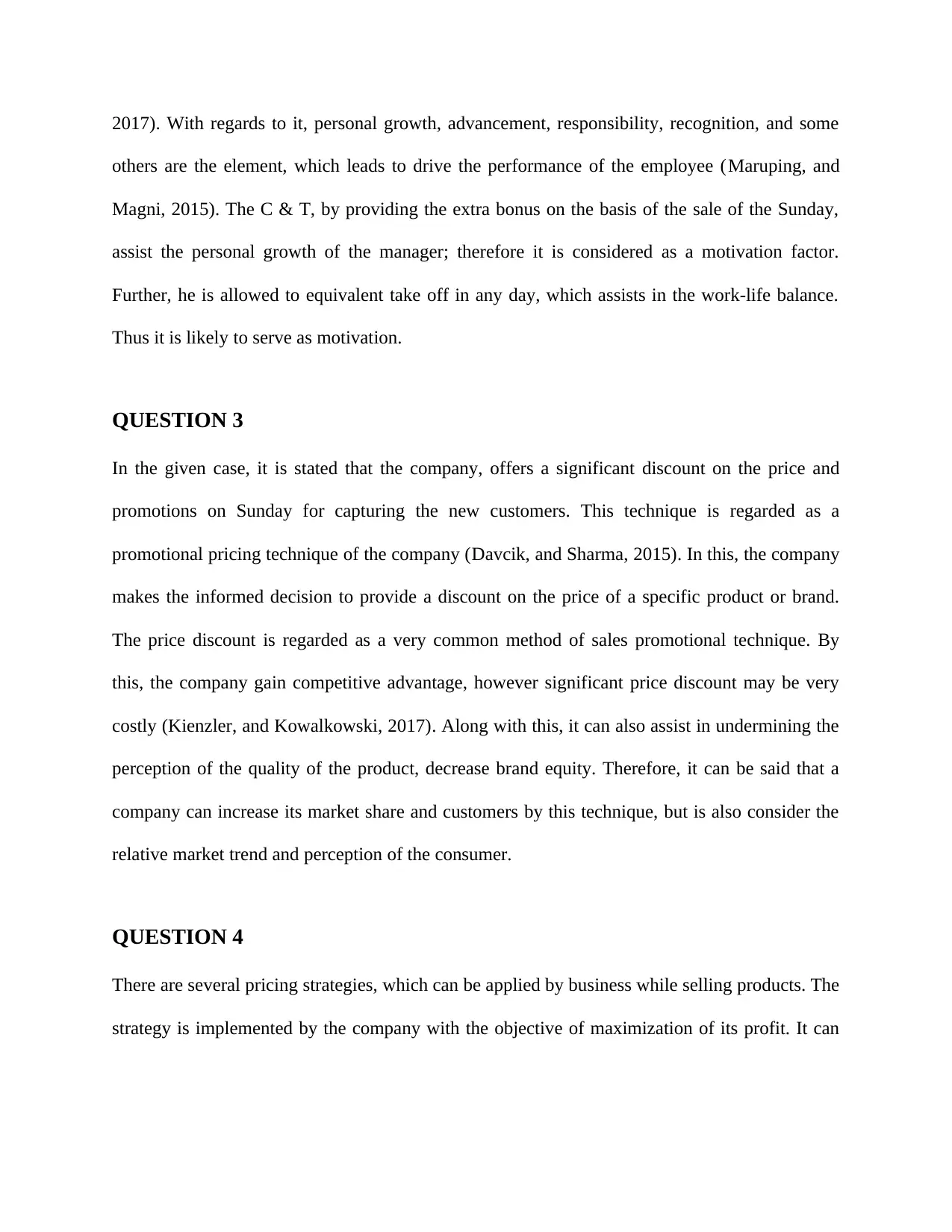
2017). With regards to it, personal growth, advancement, responsibility, recognition, and some
others are the element, which leads to drive the performance of the employee (Maruping, and
Magni, 2015). The C & T, by providing the extra bonus on the basis of the sale of the Sunday,
assist the personal growth of the manager; therefore it is considered as a motivation factor.
Further, he is allowed to equivalent take off in any day, which assists in the work-life balance.
Thus it is likely to serve as motivation.
QUESTION 3
In the given case, it is stated that the company, offers a significant discount on the price and
promotions on Sunday for capturing the new customers. This technique is regarded as a
promotional pricing technique of the company (Davcik, and Sharma, 2015). In this, the company
makes the informed decision to provide a discount on the price of a specific product or brand.
The price discount is regarded as a very common method of sales promotional technique. By
this, the company gain competitive advantage, however significant price discount may be very
costly (Kienzler, and Kowalkowski, 2017). Along with this, it can also assist in undermining the
perception of the quality of the product, decrease brand equity. Therefore, it can be said that a
company can increase its market share and customers by this technique, but is also consider the
relative market trend and perception of the consumer.
QUESTION 4
There are several pricing strategies, which can be applied by business while selling products. The
strategy is implemented by the company with the objective of maximization of its profit. It can
others are the element, which leads to drive the performance of the employee (Maruping, and
Magni, 2015). The C & T, by providing the extra bonus on the basis of the sale of the Sunday,
assist the personal growth of the manager; therefore it is considered as a motivation factor.
Further, he is allowed to equivalent take off in any day, which assists in the work-life balance.
Thus it is likely to serve as motivation.
QUESTION 3
In the given case, it is stated that the company, offers a significant discount on the price and
promotions on Sunday for capturing the new customers. This technique is regarded as a
promotional pricing technique of the company (Davcik, and Sharma, 2015). In this, the company
makes the informed decision to provide a discount on the price of a specific product or brand.
The price discount is regarded as a very common method of sales promotional technique. By
this, the company gain competitive advantage, however significant price discount may be very
costly (Kienzler, and Kowalkowski, 2017). Along with this, it can also assist in undermining the
perception of the quality of the product, decrease brand equity. Therefore, it can be said that a
company can increase its market share and customers by this technique, but is also consider the
relative market trend and perception of the consumer.
QUESTION 4
There are several pricing strategies, which can be applied by business while selling products. The
strategy is implemented by the company with the objective of maximization of its profit. It can
Paraphrase This Document
Need a fresh take? Get an instant paraphrase of this document with our AI Paraphraser

be applied to enter into the new market, gain competitive advantages or defend the present
market from the new entrants (Xu, Frankwick, and Ramirez, 2016).
In the given case, the product manufactured by the PAX is unique and will improve the servicing
efficiency of the garages. Further, the competitor of this product can develop this product within
the next six month. On the basis of this, it is advisable to the PAX, to apply the price skimming
policy at the initial face of the product. In the initial phase, the cost of the product is high,
however by higher selling price; the company can generate more profit. In the price skimming
policy, company fix the high rate of the product during the introductory face and gradually lower
down the price as the competitor of the goods enters into the market (Baykasoğlu, Gölcük, and
Akyol, 2017). Since the product is unique quality, and there is no competitor at the introductory
phase of the product, by this customer can pay the more price and company can maximize its
profit. After the entrants of the new competitor, by lowering down the price of the product as
compared with the competitor, the company can capture the customers (Rapaccini, 2015).
QUESTION 5
Calculation of the selling price by which PAX can maximize its profit –
The relationship between the price and marginal revenue is given,
P = a-bx
Mr = a-2bx
Long Run variable cost = 320 per unit
market from the new entrants (Xu, Frankwick, and Ramirez, 2016).
In the given case, the product manufactured by the PAX is unique and will improve the servicing
efficiency of the garages. Further, the competitor of this product can develop this product within
the next six month. On the basis of this, it is advisable to the PAX, to apply the price skimming
policy at the initial face of the product. In the initial phase, the cost of the product is high,
however by higher selling price; the company can generate more profit. In the price skimming
policy, company fix the high rate of the product during the introductory face and gradually lower
down the price as the competitor of the goods enters into the market (Baykasoğlu, Gölcük, and
Akyol, 2017). Since the product is unique quality, and there is no competitor at the introductory
phase of the product, by this customer can pay the more price and company can maximize its
profit. After the entrants of the new competitor, by lowering down the price of the product as
compared with the competitor, the company can capture the customers (Rapaccini, 2015).
QUESTION 5
Calculation of the selling price by which PAX can maximize its profit –
The relationship between the price and marginal revenue is given,
P = a-bx
Mr = a-2bx
Long Run variable cost = 320 per unit
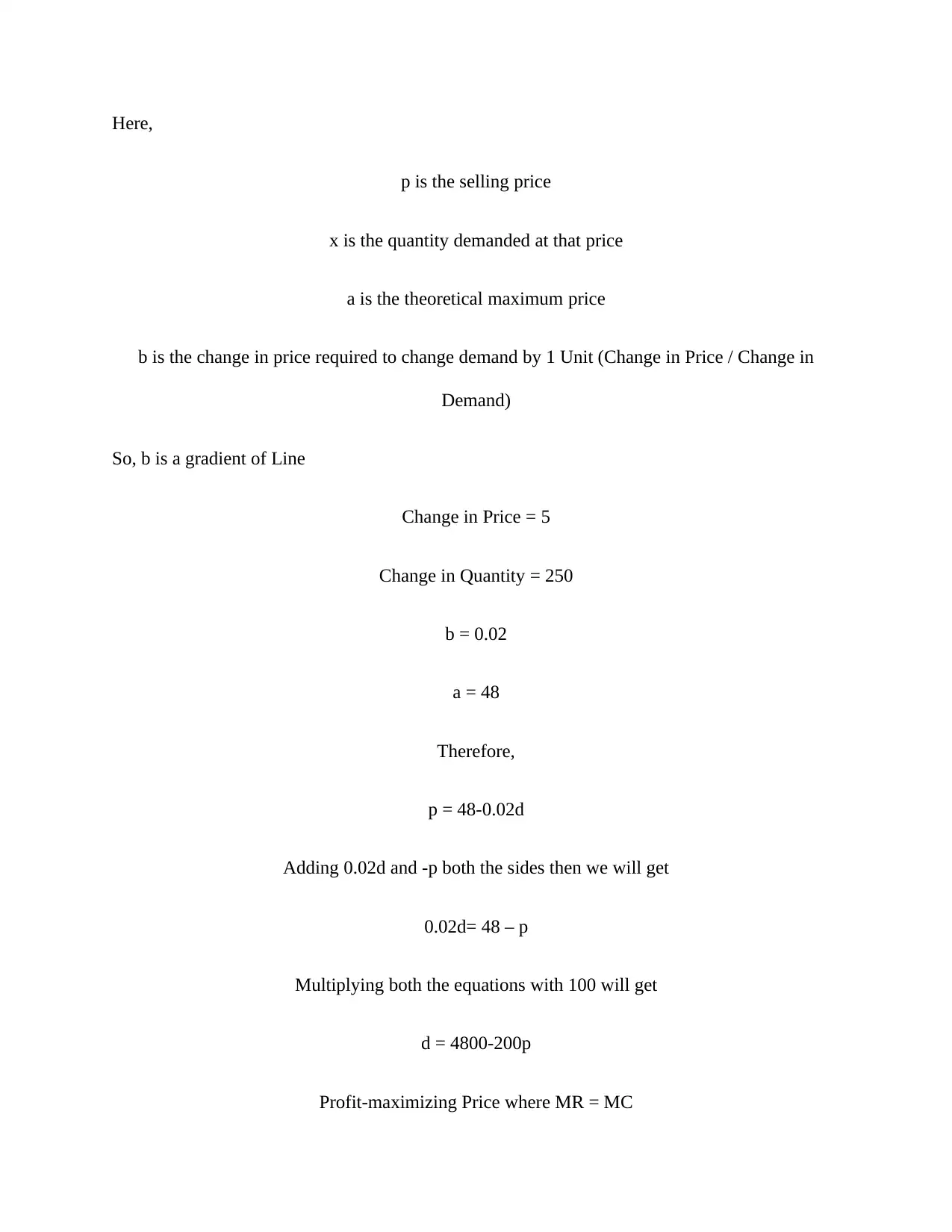
Here,
p is the selling price
x is the quantity demanded at that price
a is the theoretical maximum price
b is the change in price required to change demand by 1 Unit (Change in Price / Change in
Demand)
So, b is a gradient of Line
Change in Price = 5
Change in Quantity = 250
b = 0.02
a = 48
Therefore,
p = 48-0.02d
Adding 0.02d and -p both the sides then we will get
0.02d= 48 – p
Multiplying both the equations with 100 will get
d = 4800-200p
Profit-maximizing Price where MR = MC
p is the selling price
x is the quantity demanded at that price
a is the theoretical maximum price
b is the change in price required to change demand by 1 Unit (Change in Price / Change in
Demand)
So, b is a gradient of Line
Change in Price = 5
Change in Quantity = 250
b = 0.02
a = 48
Therefore,
p = 48-0.02d
Adding 0.02d and -p both the sides then we will get
0.02d= 48 – p
Multiplying both the equations with 100 will get
d = 4800-200p
Profit-maximizing Price where MR = MC
⊘ This is a preview!⊘
Do you want full access?
Subscribe today to unlock all pages.

Trusted by 1+ million students worldwide
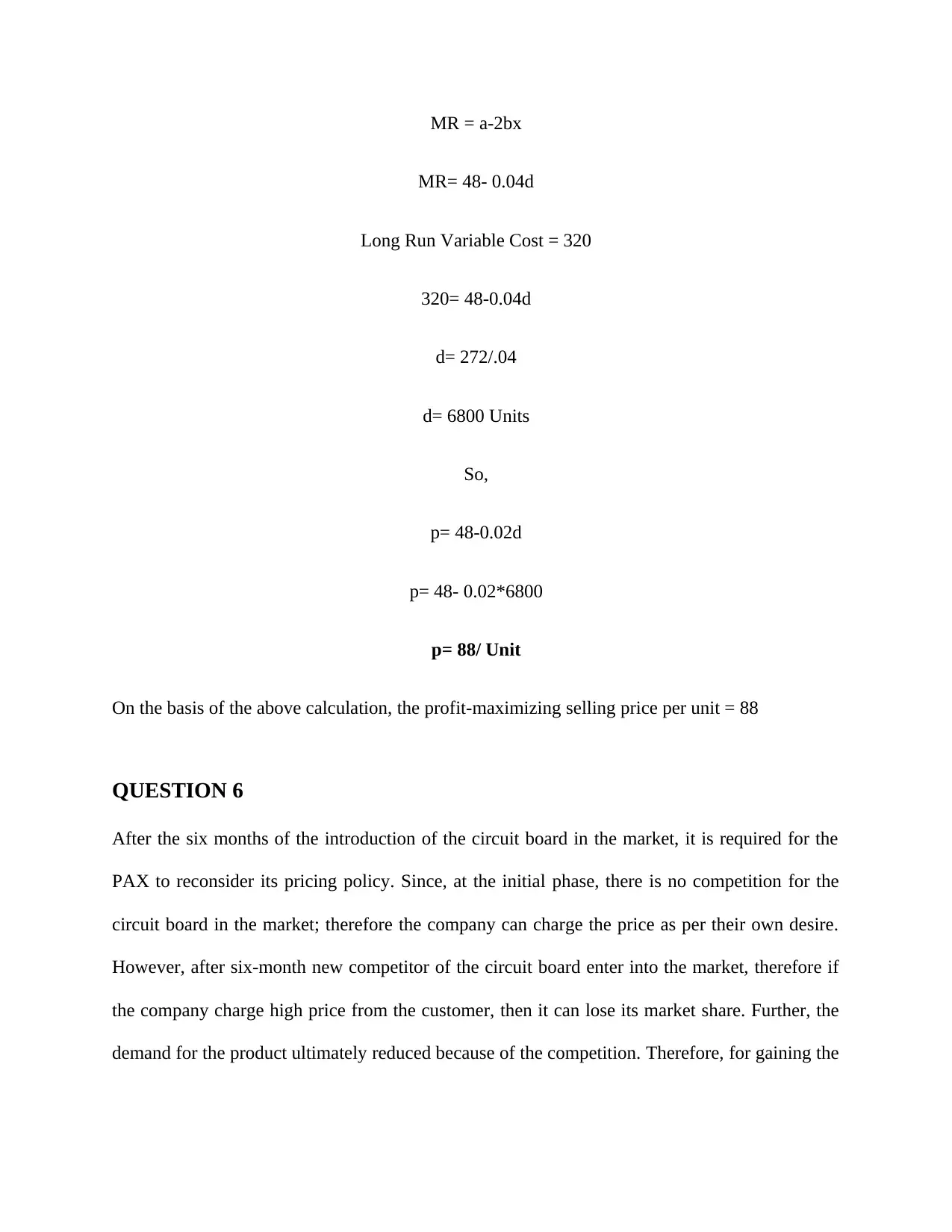
MR = a-2bx
MR= 48- 0.04d
Long Run Variable Cost = 320
320= 48-0.04d
d= 272/.04
d= 6800 Units
So,
p= 48-0.02d
p= 48- 0.02*6800
p= 88/ Unit
On the basis of the above calculation, the profit-maximizing selling price per unit = 88
QUESTION 6
After the six months of the introduction of the circuit board in the market, it is required for the
PAX to reconsider its pricing policy. Since, at the initial phase, there is no competition for the
circuit board in the market; therefore the company can charge the price as per their own desire.
However, after six-month new competitor of the circuit board enter into the market, therefore if
the company charge high price from the customer, then it can lose its market share. Further, the
demand for the product ultimately reduced because of the competition. Therefore, for gaining the
MR= 48- 0.04d
Long Run Variable Cost = 320
320= 48-0.04d
d= 272/.04
d= 6800 Units
So,
p= 48-0.02d
p= 48- 0.02*6800
p= 88/ Unit
On the basis of the above calculation, the profit-maximizing selling price per unit = 88
QUESTION 6
After the six months of the introduction of the circuit board in the market, it is required for the
PAX to reconsider its pricing policy. Since, at the initial phase, there is no competition for the
circuit board in the market; therefore the company can charge the price as per their own desire.
However, after six-month new competitor of the circuit board enter into the market, therefore if
the company charge high price from the customer, then it can lose its market share. Further, the
demand for the product ultimately reduced because of the competition. Therefore, for gaining the
Paraphrase This Document
Need a fresh take? Get an instant paraphrase of this document with our AI Paraphraser
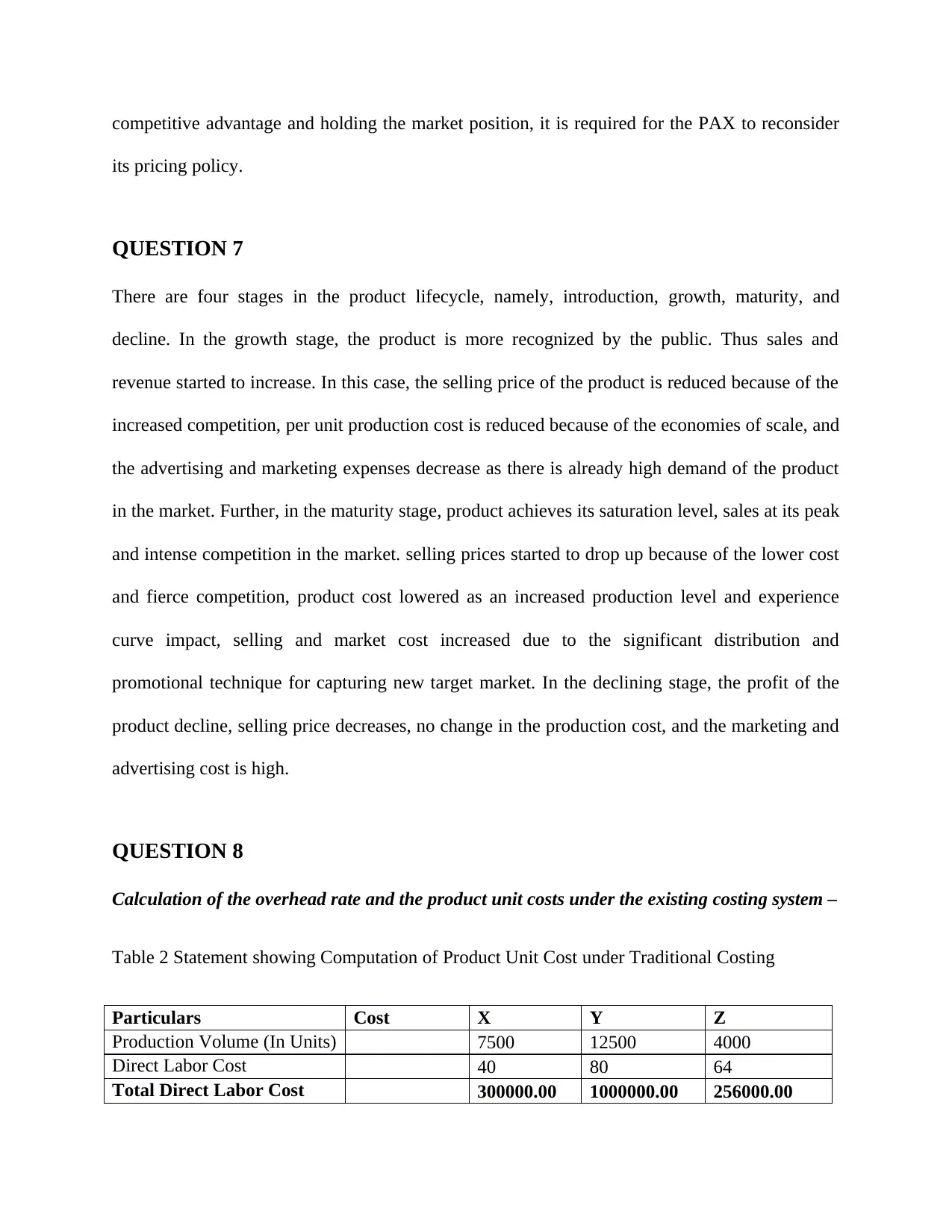
competitive advantage and holding the market position, it is required for the PAX to reconsider
its pricing policy.
QUESTION 7
There are four stages in the product lifecycle, namely, introduction, growth, maturity, and
decline. In the growth stage, the product is more recognized by the public. Thus sales and
revenue started to increase. In this case, the selling price of the product is reduced because of the
increased competition, per unit production cost is reduced because of the economies of scale, and
the advertising and marketing expenses decrease as there is already high demand of the product
in the market. Further, in the maturity stage, product achieves its saturation level, sales at its peak
and intense competition in the market. selling prices started to drop up because of the lower cost
and fierce competition, product cost lowered as an increased production level and experience
curve impact, selling and market cost increased due to the significant distribution and
promotional technique for capturing new target market. In the declining stage, the profit of the
product decline, selling price decreases, no change in the production cost, and the marketing and
advertising cost is high.
QUESTION 8
Calculation of the overhead rate and the product unit costs under the existing costing system –
Table 2 Statement showing Computation of Product Unit Cost under Traditional Costing
Particulars Cost X Y Z
Production Volume (In Units) 7500 12500 4000
Direct Labor Cost 40 80 64
Total Direct Labor Cost 300000.00 1000000.00 256000.00
its pricing policy.
QUESTION 7
There are four stages in the product lifecycle, namely, introduction, growth, maturity, and
decline. In the growth stage, the product is more recognized by the public. Thus sales and
revenue started to increase. In this case, the selling price of the product is reduced because of the
increased competition, per unit production cost is reduced because of the economies of scale, and
the advertising and marketing expenses decrease as there is already high demand of the product
in the market. Further, in the maturity stage, product achieves its saturation level, sales at its peak
and intense competition in the market. selling prices started to drop up because of the lower cost
and fierce competition, product cost lowered as an increased production level and experience
curve impact, selling and market cost increased due to the significant distribution and
promotional technique for capturing new target market. In the declining stage, the profit of the
product decline, selling price decreases, no change in the production cost, and the marketing and
advertising cost is high.
QUESTION 8
Calculation of the overhead rate and the product unit costs under the existing costing system –
Table 2 Statement showing Computation of Product Unit Cost under Traditional Costing
Particulars Cost X Y Z
Production Volume (In Units) 7500 12500 4000
Direct Labor Cost 40 80 64
Total Direct Labor Cost 300000.00 1000000.00 256000.00
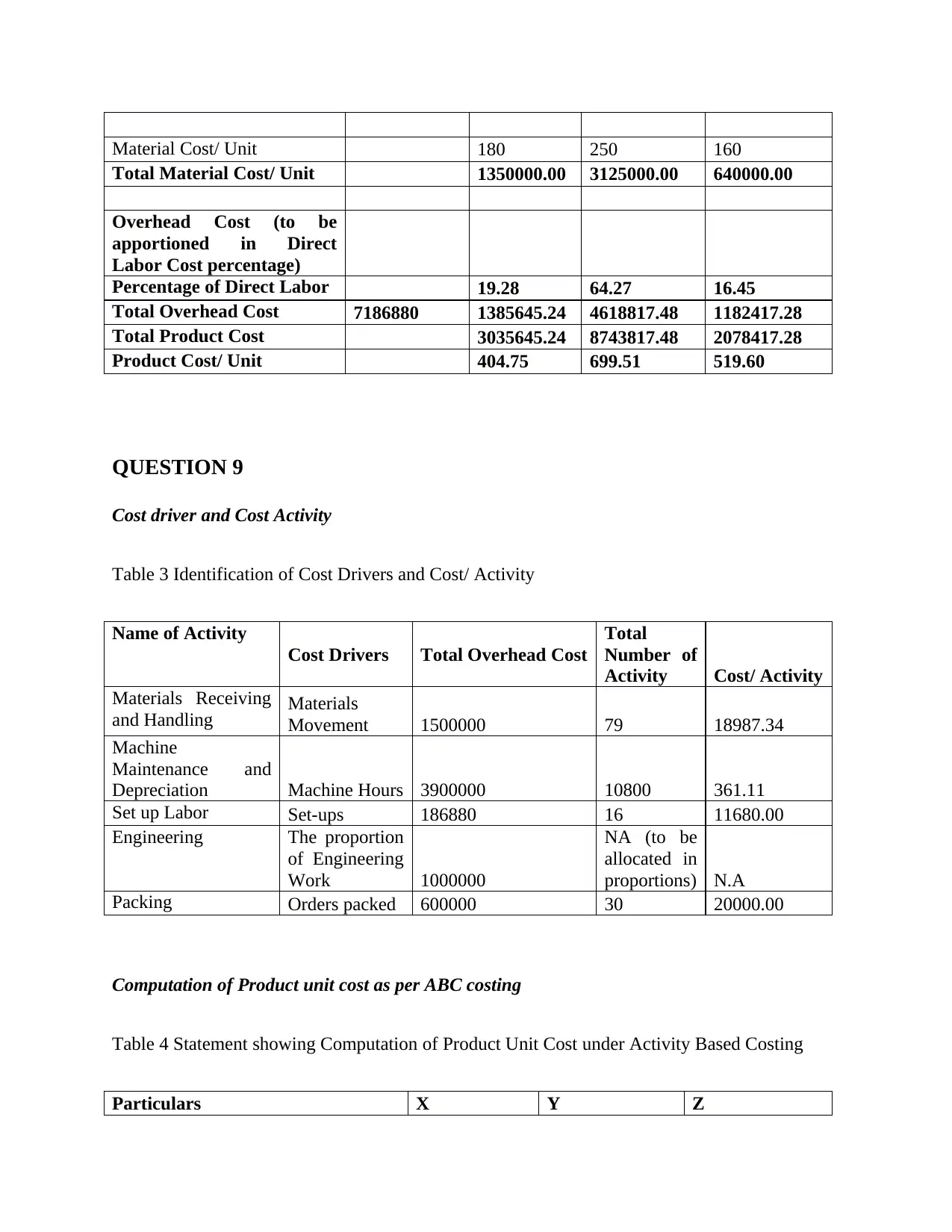
Material Cost/ Unit 180 250 160
Total Material Cost/ Unit 1350000.00 3125000.00 640000.00
Overhead Cost (to be
apportioned in Direct
Labor Cost percentage)
Percentage of Direct Labor 19.28 64.27 16.45
Total Overhead Cost 7186880 1385645.24 4618817.48 1182417.28
Total Product Cost 3035645.24 8743817.48 2078417.28
Product Cost/ Unit 404.75 699.51 519.60
QUESTION 9
Cost driver and Cost Activity
Table 3 Identification of Cost Drivers and Cost/ Activity
Name of Activity
Cost Drivers Total Overhead Cost
Total
Number of
Activity Cost/ Activity
Materials Receiving
and Handling Materials
Movement 1500000 79 18987.34
Machine
Maintenance and
Depreciation Machine Hours 3900000 10800 361.11
Set up Labor Set-ups 186880 16 11680.00
Engineering The proportion
of Engineering
Work 1000000
NA (to be
allocated in
proportions) N.A
Packing Orders packed 600000 30 20000.00
Computation of Product unit cost as per ABC costing
Table 4 Statement showing Computation of Product Unit Cost under Activity Based Costing
Particulars X Y Z
Total Material Cost/ Unit 1350000.00 3125000.00 640000.00
Overhead Cost (to be
apportioned in Direct
Labor Cost percentage)
Percentage of Direct Labor 19.28 64.27 16.45
Total Overhead Cost 7186880 1385645.24 4618817.48 1182417.28
Total Product Cost 3035645.24 8743817.48 2078417.28
Product Cost/ Unit 404.75 699.51 519.60
QUESTION 9
Cost driver and Cost Activity
Table 3 Identification of Cost Drivers and Cost/ Activity
Name of Activity
Cost Drivers Total Overhead Cost
Total
Number of
Activity Cost/ Activity
Materials Receiving
and Handling Materials
Movement 1500000 79 18987.34
Machine
Maintenance and
Depreciation Machine Hours 3900000 10800 361.11
Set up Labor Set-ups 186880 16 11680.00
Engineering The proportion
of Engineering
Work 1000000
NA (to be
allocated in
proportions) N.A
Packing Orders packed 600000 30 20000.00
Computation of Product unit cost as per ABC costing
Table 4 Statement showing Computation of Product Unit Cost under Activity Based Costing
Particulars X Y Z
⊘ This is a preview!⊘
Do you want full access?
Subscribe today to unlock all pages.

Trusted by 1+ million students worldwide
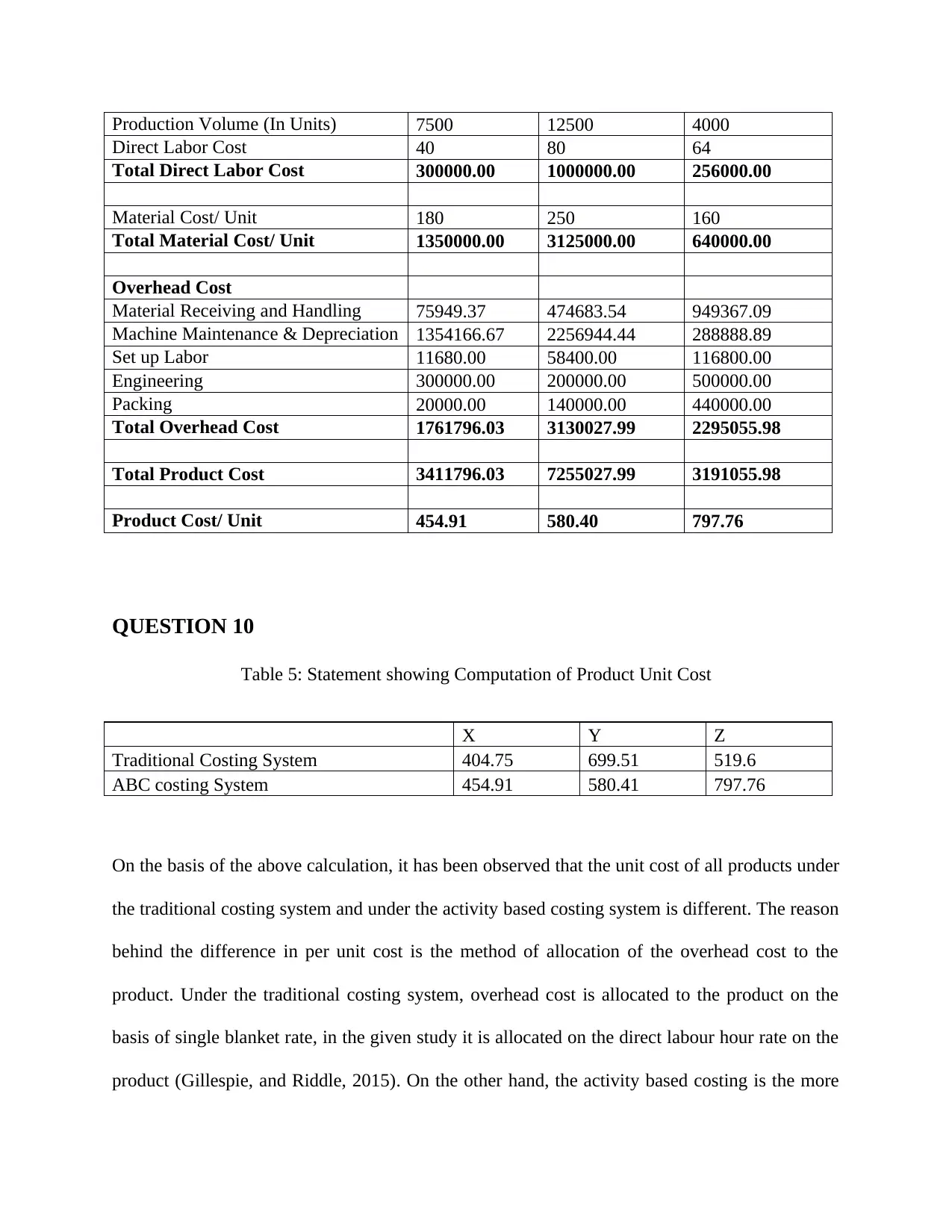
Production Volume (In Units) 7500 12500 4000
Direct Labor Cost 40 80 64
Total Direct Labor Cost 300000.00 1000000.00 256000.00
Material Cost/ Unit 180 250 160
Total Material Cost/ Unit 1350000.00 3125000.00 640000.00
Overhead Cost
Material Receiving and Handling 75949.37 474683.54 949367.09
Machine Maintenance & Depreciation 1354166.67 2256944.44 288888.89
Set up Labor 11680.00 58400.00 116800.00
Engineering 300000.00 200000.00 500000.00
Packing 20000.00 140000.00 440000.00
Total Overhead Cost 1761796.03 3130027.99 2295055.98
Total Product Cost 3411796.03 7255027.99 3191055.98
Product Cost/ Unit 454.91 580.40 797.76
QUESTION 10
Table 5: Statement showing Computation of Product Unit Cost
X Y Z
Traditional Costing System 404.75 699.51 519.6
ABC costing System 454.91 580.41 797.76
On the basis of the above calculation, it has been observed that the unit cost of all products under
the traditional costing system and under the activity based costing system is different. The reason
behind the difference in per unit cost is the method of allocation of the overhead cost to the
product. Under the traditional costing system, overhead cost is allocated to the product on the
basis of single blanket rate, in the given study it is allocated on the direct labour hour rate on the
product (Gillespie, and Riddle, 2015). On the other hand, the activity based costing is the more
Direct Labor Cost 40 80 64
Total Direct Labor Cost 300000.00 1000000.00 256000.00
Material Cost/ Unit 180 250 160
Total Material Cost/ Unit 1350000.00 3125000.00 640000.00
Overhead Cost
Material Receiving and Handling 75949.37 474683.54 949367.09
Machine Maintenance & Depreciation 1354166.67 2256944.44 288888.89
Set up Labor 11680.00 58400.00 116800.00
Engineering 300000.00 200000.00 500000.00
Packing 20000.00 140000.00 440000.00
Total Overhead Cost 1761796.03 3130027.99 2295055.98
Total Product Cost 3411796.03 7255027.99 3191055.98
Product Cost/ Unit 454.91 580.40 797.76
QUESTION 10
Table 5: Statement showing Computation of Product Unit Cost
X Y Z
Traditional Costing System 404.75 699.51 519.6
ABC costing System 454.91 580.41 797.76
On the basis of the above calculation, it has been observed that the unit cost of all products under
the traditional costing system and under the activity based costing system is different. The reason
behind the difference in per unit cost is the method of allocation of the overhead cost to the
product. Under the traditional costing system, overhead cost is allocated to the product on the
basis of single blanket rate, in the given study it is allocated on the direct labour hour rate on the
product (Gillespie, and Riddle, 2015). On the other hand, the activity based costing is the more
Paraphrase This Document
Need a fresh take? Get an instant paraphrase of this document with our AI Paraphraser
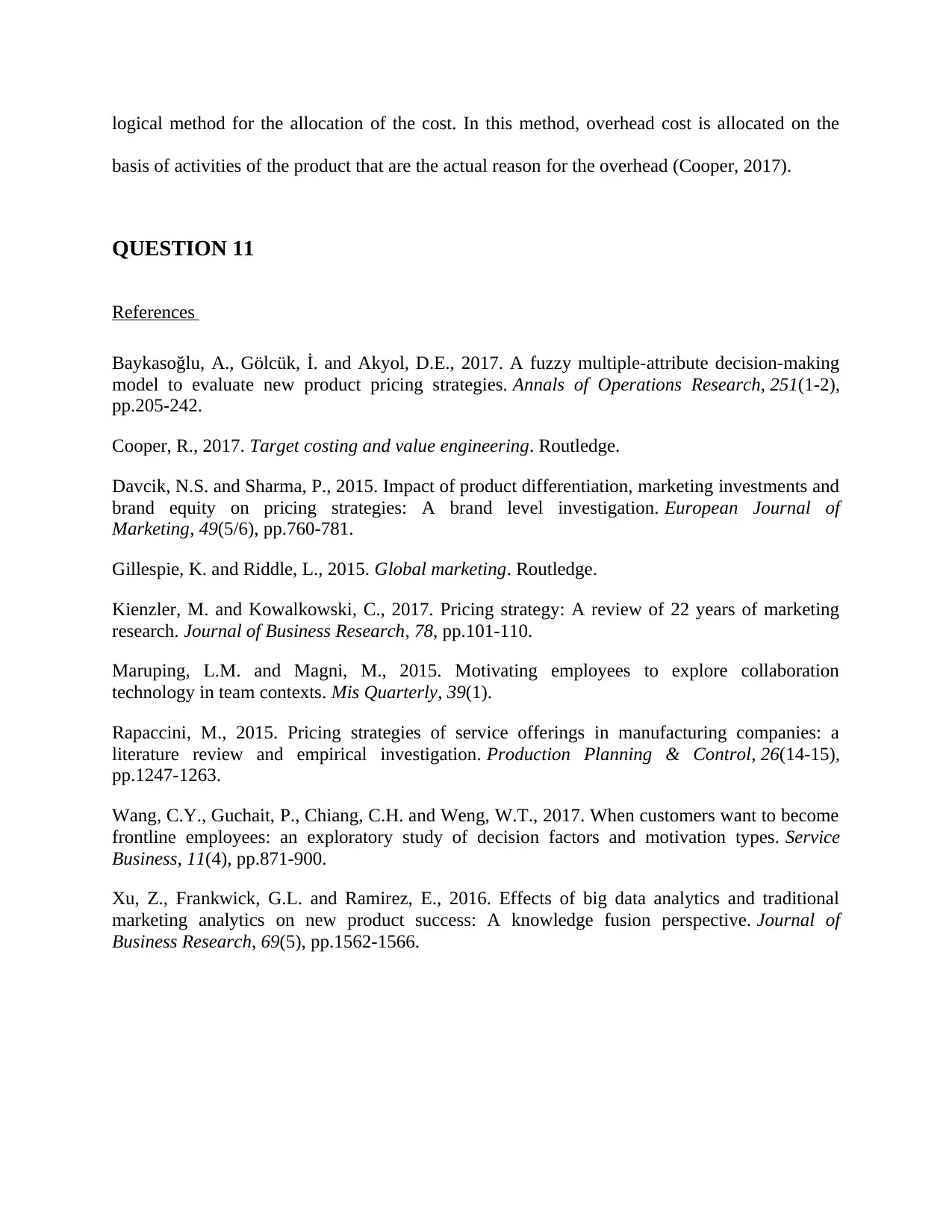
logical method for the allocation of the cost. In this method, overhead cost is allocated on the
basis of activities of the product that are the actual reason for the overhead (Cooper, 2017).
QUESTION 11
References
Baykasoğlu, A., Gölcük, İ. and Akyol, D.E., 2017. A fuzzy multiple-attribute decision-making
model to evaluate new product pricing strategies. Annals of Operations Research, 251(1-2),
pp.205-242.
Cooper, R., 2017. Target costing and value engineering. Routledge.
Davcik, N.S. and Sharma, P., 2015. Impact of product differentiation, marketing investments and
brand equity on pricing strategies: A brand level investigation. European Journal of
Marketing, 49(5/6), pp.760-781.
Gillespie, K. and Riddle, L., 2015. Global marketing. Routledge.
Kienzler, M. and Kowalkowski, C., 2017. Pricing strategy: A review of 22 years of marketing
research. Journal of Business Research, 78, pp.101-110.
Maruping, L.M. and Magni, M., 2015. Motivating employees to explore collaboration
technology in team contexts. Mis Quarterly, 39(1).
Rapaccini, M., 2015. Pricing strategies of service offerings in manufacturing companies: a
literature review and empirical investigation. Production Planning & Control, 26(14-15),
pp.1247-1263.
Wang, C.Y., Guchait, P., Chiang, C.H. and Weng, W.T., 2017. When customers want to become
frontline employees: an exploratory study of decision factors and motivation types. Service
Business, 11(4), pp.871-900.
Xu, Z., Frankwick, G.L. and Ramirez, E., 2016. Effects of big data analytics and traditional
marketing analytics on new product success: A knowledge fusion perspective. Journal of
Business Research, 69(5), pp.1562-1566.
basis of activities of the product that are the actual reason for the overhead (Cooper, 2017).
QUESTION 11
References
Baykasoğlu, A., Gölcük, İ. and Akyol, D.E., 2017. A fuzzy multiple-attribute decision-making
model to evaluate new product pricing strategies. Annals of Operations Research, 251(1-2),
pp.205-242.
Cooper, R., 2017. Target costing and value engineering. Routledge.
Davcik, N.S. and Sharma, P., 2015. Impact of product differentiation, marketing investments and
brand equity on pricing strategies: A brand level investigation. European Journal of
Marketing, 49(5/6), pp.760-781.
Gillespie, K. and Riddle, L., 2015. Global marketing. Routledge.
Kienzler, M. and Kowalkowski, C., 2017. Pricing strategy: A review of 22 years of marketing
research. Journal of Business Research, 78, pp.101-110.
Maruping, L.M. and Magni, M., 2015. Motivating employees to explore collaboration
technology in team contexts. Mis Quarterly, 39(1).
Rapaccini, M., 2015. Pricing strategies of service offerings in manufacturing companies: a
literature review and empirical investigation. Production Planning & Control, 26(14-15),
pp.1247-1263.
Wang, C.Y., Guchait, P., Chiang, C.H. and Weng, W.T., 2017. When customers want to become
frontline employees: an exploratory study of decision factors and motivation types. Service
Business, 11(4), pp.871-900.
Xu, Z., Frankwick, G.L. and Ramirez, E., 2016. Effects of big data analytics and traditional
marketing analytics on new product success: A knowledge fusion perspective. Journal of
Business Research, 69(5), pp.1562-1566.
1 out of 11
Related Documents
Your All-in-One AI-Powered Toolkit for Academic Success.
+13062052269
info@desklib.com
Available 24*7 on WhatsApp / Email
![[object Object]](/_next/static/media/star-bottom.7253800d.svg)
Unlock your academic potential
Copyright © 2020–2025 A2Z Services. All Rights Reserved. Developed and managed by ZUCOL.





